Image

Suzanne M. Walsh, Chief Executive Officer, Kennebec Valley Community Action Program
Challenge: There are many families in need of services who don’t fit the criteria necessary for government assistance. While not technically under the poverty line, many families still struggle with insecurity and scarcity, but have no safety net to fall back on in times of difficulty.
It’s tough trying to fit a square peg into a round hole, yet that is the metaphorical challenge many people with limited income face when trying to access social-assistance programs. Some examples: A single mother faces eviction because she is unable to afford the required garbage bags and bucket. A single father without a car can’t run errands because he lacks a stroller to transport his growing son. An elderly couple with serious medical conditions cannot leave a homeless shelter due to inability to put down a security deposit. A young woman has insurance to cover her eye appointment, but no funds to actually purchase the glasses she needs to see effectively.
There are no public-assistance programs that will pay for garbage bags, the stroller, the security deposit or glasses. So who helps these people overcome their challenges?
In Waterville, Maine, and the surrounding community, it’s the Community Investor Initiative, a program of the local Poverty Action Coalition—a group of concerned individuals and organizations who came together to address barriers to prosperity. Each and every one of the above situations was resolved with the support of a community willing to help neighbors in need.
In January 2014, the first meeting of the coalition was convened by the mayor of Waterville. The Kennebec Valley Community Action Program (KVCAP), whose mission is to eliminate poverty and the conditions of poverty, joined with other community stakeholders to fight a staggering blight. In Waterville, the poverty rate is nearly 22 percent, compared with 13.4 percent for the county and 13.6 percent for the state. Nearly 70 percent of Waterville’s children under the age of five live in poverty. According to the Maine Department of Education, more than two thirds of students in the Waterville school district qualify for free or reduced lunch.
 The Poverty Action Coalition, spearheaded by KVCAP, is by definition a collaborative endeavor. Its 85 members include Waterville city officials, representatives from the local college, public library staff, social service providers and dozens of other stakeholders. Anyone who is interested in working on poverty issues in the Waterville area is welcome at the table.
The Poverty Action Coalition, spearheaded by KVCAP, is by definition a collaborative endeavor. Its 85 members include Waterville city officials, representatives from the local college, public library staff, social service providers and dozens of other stakeholders. Anyone who is interested in working on poverty issues in the Waterville area is welcome at the table.Established in 2015, the Community Investors Initiative (CII) is the first program developed by the coalition. It exists to make small grants or assist with other interventions when emergency assistance is needed to overcome an immediate problem and prevent a long-term catastrophe. To avoid duplication of services, an application process ensures that every other avenue of assistance is pursued before a request is brought to the CII.
CII investors, currently made up of more than 200 members, are asked to develop solutions to resident issues, whether it is sharing an unknown resource or donating money/items. If no solution is offered by the Community Investors members, then the Poverty Action Coalition may choose to fulfill the request through the Hope Fund, which was specifically set up to meet these types of needs.
In 2015, 61 individuals were helped with assistance that included a bus ticket back to go home to a more stable support network, a security deposit, a microwave and a storage-unit fee.
Because we were not sure in the beginning what types of assistance would be needed, it was not possible to set rules ahead of time. Understanding the necessary logistics of the program and how to best meet the clients’ needs has evolved with the types of requests received. We found that meeting once a week for the first three months significantly helped. We were able to keep each other updated on areas we were finding too difficult to administer. For example, we tried to collect and deliver furniture for our clients but discovered, as a group, that this was extremely challenging to manage and sustain. Instead, we set up a relationship with a furniture store and Habitat for Humanity Restore to address this need.
The most unique aspect of the program is how many people are helped without having to involve the community investors. More importantly, we found new ways to approach clients and their challenges.
While the individual outcomes may seem small—a pair of glasses here, a security deposit there, even a kitchen sink for one family—the collective contributions of the Community Investors make a world of difference. Moreover, the initiative has enhanced relationships between partner agencies over our shared clients. The interest generated by the success of the CII has encouraged other communities to look at implementing a similar model in their regions.

